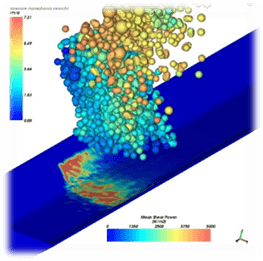- PRODUCTS
- SERVICES
- HARDWARE & IT
- LEARNING & DEVELOPMENT
- CADFEM INFORMS
CADFEM INFORMS OVERVIEW
- ABOUT US


Punctures in transfer chute plates are often caused by impact or abrasive wear from material handling. This damage might result in costly repairs and downtime.
Uncontrolled material flow generated by a poorly built discharge section frequently results in spillage, posing safety risks and material loss.
A non-centralized or peripheral discharge can create conveyor belt wobble, resulting in uneven wear and possible operational disturbances.
Jamming is common in sections with smaller cross-sections or when handling materials with high moisture content, resulting in obstructions and lower efficiency.

Ansys Rocky calculates each granule or particle’s behaviour, as well as its interactions with the chute plate and other particles, using the Discrete Element Method (DEM). This enables the prediction of ideal material trajectories by studying millions of particles at the same time using hardware capabilities.
Rocky carefully monitors the equipment’s operation using basic inputs such as feed rate, lump size, belt speed, and bulk density, providing insights that might assist improve performance.
Rocky simulations save prototype costs by allowing virtual testing and redesign of equipment, which reduces the need for real trials.
The software offers extensive information on forces, energy, velocities, and other characteristics at all times, assisting in identifying and resolving equipment issues.
Rocky provides brief insights on material behaviour, enabling for forecasts of equipment longevity and planning for maintenance-related shutdowns.
If the chute is lined, Rocky can clearly see wear patterns, allowing him to make educated judgments regarding replacing or repairing the design.
Although chutes are sometimes disregarded, they are critical components that can pose major problems if not properly maintained. Addressing these issues early on saves significant expenses in the long term.
Rocky provides a significant return on investment, frequently exceeding the initial outlay, by avoiding expensive breakdowns and enhancing chute performance.


